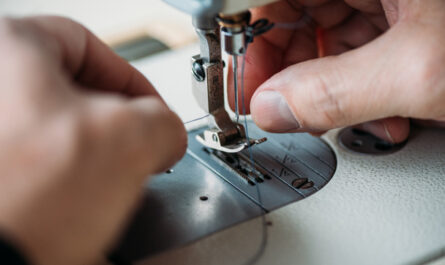In today’s fast-paced world of mass-produced fashion, expressing your unique style can feel like a challenge. However, DIY fashion projects are making it easier than ever to transform ordinary pieces into personalized treasures. Whether you’re looking to breathe new life into old favorites or create entirely unique garments from scratch, DIY fashion allows you to customize your wardrobe, reflect your personality, and even save money—all while engaging in a fun and creative activity.
This comprehensive guide will explore a range of DIY fashion projects that cater to different skill levels and styles. From simple alterations and upcycling techniques to advanced embroidery and fabric painting, we’ll dive into the methods and materials that can help you add that personal touch to every outfit. Get ready to unleash your creativity and discover the transformative power of DIY fashion.
1. The Benefits of DIY Fashion
A. Expressing Individuality
One of the most significant advantages of DIY fashion is the ability to express your individuality. In a market saturated with similar styles, customizing your clothing means that no one else will have pieces exactly like yours. Personalized touches—from unique embellishments to custom prints—allow you to create a wardrobe that truly reflects who you are.
B. Sustainability and Eco-Friendliness
DIY fashion is also an eco-friendly alternative to fast fashion. By upcycling old garments or repurposing thrift store finds, you reduce waste and contribute to a more sustainable lifestyle. This approach not only minimizes your environmental impact but also supports the idea of reusing resources in innovative ways.
C. Budget-Friendly Creativity
Another key benefit is the cost-effectiveness of DIY projects. Instead of spending money on new, often expensive clothing, you can transform items you already own into fresh, stylish pieces. Even if you decide to purchase inexpensive items specifically for customization, DIY fashion allows you to achieve a high-end look without breaking the bank.
D. Skill Development and Personal Satisfaction
Engaging in DIY fashion projects can be a highly rewarding creative outlet. As you learn new techniques—whether it’s sewing, dyeing, or embroidery—you not only develop practical skills but also gain a sense of accomplishment from making something with your own hands. This personal growth and satisfaction can boost your confidence, both in your creativity and your overall style.
2. Getting Started: Tools and Materials You’ll Need
Before diving into DIY projects, it’s important to equip yourself with the right tools and materials. The following list covers some basic items that will serve as your toolkit for a wide range of fashion projects:
A. Basic Sewing Kit
- Sewing Machine: While hand sewing works for simple tasks, a sewing machine makes alterations faster and more precise.
- Needles and Thread: Keep a variety of needles and threads in different colors to match your fabrics.
- Scissors: A good pair of fabric scissors is essential for clean cuts.
- Pins and Pincushion: To hold fabric pieces together while sewing.
- Measuring Tape: Accurate measurements are crucial for alterations and customizations.
B. Fabric and Notions
- Fabric Paint and Markers: For decorating and adding patterns to plain garments.
- Embroidery Floss and Needles: Perfect for adding intricate designs and embellishments.
- Iron-On Patches and Appliques: Great for adding visual interest or repairing holes.
- Velcro, Buttons, and Zippers: Useful for creating closures and adding functional details.
- Fabrics: Consider purchasing unique or complementary fabrics for patchwork or layering projects.
C. Additional Creative Tools
- Stencils and Templates: These can help create consistent designs on fabric.
- Fabric Dye and Brushes: For tie-dye or batik projects that add a burst of color to your clothing.
- Heat Transfer Vinyl: A modern tool that allows you to cut out designs with a machine and apply them with heat.
Having these tools at hand sets the stage for a successful DIY fashion journey, enabling you to tackle projects with confidence.
3. DIY Fashion Projects for Every Skill Level
Whether you’re a beginner or a seasoned crafter, there’s a DIY fashion project for you. Below are some ideas categorized by skill level, ensuring that you can find something that fits your experience and interests.
A. Beginner Projects
1. Upcycling Old T-Shirts
One of the easiest ways to start your DIY fashion journey is by upcycling old t-shirts. Instead of tossing worn-out shirts, transform them into something new and stylish.
- Tie-Dye T-Shirts: Experiment with different dye techniques to create unique patterns. Use rubber bands to create stripes or spirals, and explore various color combinations.
- Cut-and-Sew Designs: Turn a plain t-shirt into a crop top or a tank top by cutting and hemming. This project teaches basic cutting, measuring, and sewing techniques.
- Embellishments: Add patches, appliques, or even fabric paint designs to personalize your t-shirt. These additions can reflect your personality or current trends.
2. Customizing Denim
Denim is a versatile fabric that lends itself well to DIY modifications. A pair of jeans or a denim jacket can be easily transformed with minimal effort.
- Distressing and Ripping: Use sandpaper, a razor, or scissors to create a distressed look. This trend has become popular for its edgy, modern appeal.
- Embroidery and Patches: Add embroidery designs or sew on patches to give your denim a personal touch. Whether it’s a small motif on the pocket or an all-over pattern, the possibilities are endless.
- Dyeing: Experiment with fabric dyes to change the color of your denim. You can achieve a vintage look with acid wash techniques or a bold statement with vibrant hues.
B. Intermediate Projects
1. Creating a Statement Skirt
Designing and sewing a skirt allows you to showcase your creativity while learning more advanced sewing techniques.
- Fabric Selection: Choose fabrics that complement your style, such as silk, cotton, or linen. Consider patterns, colors, and textures that resonate with your personal taste.
- Pattern Making: Use a basic skirt pattern as a starting point, and modify it to create a unique silhouette—whether it’s an A-line, pencil, or pleated design.
- Adding Details: Embellish your skirt with pockets, embroidery, or appliques. These details can elevate the overall look and make it a one-of-a-kind piece.
2. Revamping a Jacket
A denim or leather jacket is a timeless wardrobe staple that can be transformed with a few creative touches.
- Painting and Stenciling: Use fabric paints to add designs, quotes, or abstract patterns. Stencils can help achieve clean, consistent designs.
- Studs and Embellishments: Add metal studs, rhinestones, or patches for a bold, edgy look. This project is great for learning about accessory application and surface decoration.
- Sew-On Details: Consider sewing on contrast fabric panels or decorative trims to give your jacket a fresh new look.
C. Advanced Projects
1. Designing and Sewing a Custom Dress
For those with advanced sewing skills, designing and sewing a custom dress from scratch is a rewarding project that allows you to create a truly unique garment.
- Pattern Drafting: Start by drafting your own pattern or modifying an existing one to suit your body shape and style preferences.
- Fabric Cutting and Assembly: Choose high-quality fabrics that drape beautifully and cut them with precision. This step requires careful measurements and attention to detail.
- Intricate Embellishments: Incorporate advanced techniques such as lace appliqués, intricate embroidery, or hand-sewn beading. These details can transform a simple dress into a work of art.
- Fitting and Alterations: The process of fitting the dress and making necessary adjustments is crucial. This ensures that the final product is not only visually stunning but also comfortable and flattering.
2. Creating a Capsule Wardrobe Collection
An advanced DIY project for those looking to overhaul their style is creating a capsule wardrobe. This involves designing a cohesive collection of versatile, timeless pieces that can be mixed and matched to suit various occasions.
- Concept Development: Start by defining the style, color palette, and overall theme of your capsule wardrobe. Consider what types of garments are essential—such as a classic blazer, versatile trousers, and a signature dress.
- Design and Fabric Selection: Choose fabrics that are durable, comfortable, and appropriate for each piece. Sustainability is key here, so consider eco-friendly materials and ethical sourcing.
- Sewing and Construction: This project will challenge you to apply a range of sewing techniques, from tailoring and fitting to finishing touches and accessory integration.
- Mix and Match Philosophy: The goal of a capsule wardrobe is versatility. Ensure that each piece can be paired with others to create multiple looks, simplifying your daily routine while maintaining a stylish, cohesive aesthetic.
4. Tips for Success in DIY Fashion Projects
A. Plan Your Projects
Before diving into any DIY project, take the time to plan. Sketch out your design, list the materials you’ll need, and set a realistic timeline for completion. Planning minimizes mistakes and ensures that you have everything required to complete your project successfully.
- Create a Project Checklist: Outline each step of your project and check off tasks as you complete them.
- Budget: Estimate the cost of materials and tools. DIY projects can be budget-friendly, but having a clear financial plan helps avoid surprises.
- Set a Timeline: Establish milestones for each phase of the project, from initial design to final assembly, to stay on track.
B. Start with Simple Projects and Build Your Skills
If you’re new to DIY fashion, begin with simpler projects like upcycling t-shirts or customizing denim. As your skills and confidence grow, gradually progress to more complex projects like designing a dress or creating a capsule wardrobe.
C. Embrace Mistakes as Learning Opportunities
Not every DIY project will turn out perfectly, and that’s part of the process. Embrace mistakes as opportunities to learn and improve. Each error teaches you something new about the techniques or materials, and over time, your skills will sharpen.
- Keep a Learning Journal: Document what worked, what didn’t, and how you can improve next time.
- Celebrate Small Victories: Every successful alteration or embellishment is a step forward in your creative journey.
D. Seek Inspiration and Guidance
Leverage online tutorials, workshops, and DIY communities to expand your knowledge and skills. Platforms like YouTube, Pinterest, and various blogs offer a wealth of inspiration and step-by-step guides for every type of project.
- Join Online Forums: Engage with communities of DIY fashion enthusiasts to share tips, ask for advice, and showcase your work.
- Take a Class: If possible, enroll in a local sewing or crafting class. Hands-on guidance from experts can accelerate your learning process.
- Experiment: Don’t be afraid to try new techniques or combine different styles. Experimentation is at the heart of creativity.
5. The Transformative Power of DIY Fashion
A. Building Confidence Through Creativity
Creating your own fashion pieces is a powerful form of self-expression. When you design and craft clothing that reflects your personality, you gain a unique sense of confidence. This creative process not only allows you to showcase your individual style but also reinforces the idea that you have the power to transform your wardrobe—and your self-image.
- Personal Empowerment: DIY projects remind you that you have the skills and creativity to take control of your style. Every completed project boosts your confidence and validates your ability to create something beautiful.
- Mindful Engagement: The process of working with fabric, colors, and textures can be a meditative experience, helping to reduce stress and increase overall well-being.
B. Promoting Sustainability and Reducing Waste
DIY fashion is inherently sustainable. By repurposing old clothing and upcycling thrift store finds, you not only create unique pieces but also contribute to reducing fashion waste.
- Eco-Friendly Practices: Transforming existing garments is a great way to minimize environmental impact. You can experiment with natural dyes, repurpose fabric scraps, and even learn to mend items that would otherwise be discarded.
- Economic Benefits: DIY fashion allows you to create high-quality, personalized pieces without the high cost of designer labels. It’s a budget-friendly way to keep your wardrobe fresh and stylish.
C. Fostering a Community of Creative Expression
The world of DIY fashion is vibrant and inclusive. Joining communities of like-minded individuals can provide both inspiration and support. Sharing your projects, learning from others, and collaborating on creative ideas fosters a sense of belonging and mutual growth.
- Online Communities: Platforms like Instagram, Pinterest, and dedicated DIY fashion forums are excellent places to showcase your work and connect with others.
- Local Workshops: Attending local crafting classes or meetups can expand your network and provide hands-on opportunities to learn new techniques.
- Collaborative Projects: Consider collaborating with friends or local designers to create limited-edition collections. Collaborative efforts can yield innovative designs and strengthen community ties.
6. Inspiring DIY Fashion Success Stories
A. Transforming a Wardrobe on a Budget
Many fashion enthusiasts have turned to DIY projects as a way to reinvent their style without spending a fortune. One inspiring example is the story of a young professional who transformed her outdated wardrobe by customizing thrift store finds. Using techniques like tie-dye, embroidery, and patchwork, she created a series of unique, trend-setting pieces that not only refreshed her style but also earned her recognition on social media. Her journey highlights how creativity and resourcefulness can lead to remarkable transformations on a modest budget.
B. Reviving Vintage Pieces with Modern Flair
Vintage clothing carries a nostalgic charm that many people cherish. DIY fashion projects have become a popular way to breathe new life into vintage finds. By altering fits, adding modern embellishments, or repurposing old garments into entirely new designs, enthusiasts have created collections that honor the past while appealing to contemporary tastes. These projects demonstrate that with a little creativity, you can create timeless pieces that bridge the gap between old-world elegance and modern trends.
C. Empowering Personal Style Through Customization
For others, DIY fashion is a journey of self-discovery and empowerment. Many individuals have reported that the process of designing and creating their own clothes has helped them overcome insecurities related to body image and style. Customizing garments allows you to tailor every piece to your unique body shape, ensuring a perfect fit and a boost in confidence. Whether it’s altering a dress to accentuate your curves or designing a jacket that reflects your personality, these projects empower you to embrace your individuality and express your true self.
7. Overcoming Challenges in DIY Fashion
A. Managing Time and Skill Development
Like any creative pursuit, DIY fashion projects require time and practice. Beginners may find it challenging to balance project timelines with other responsibilities. The key is to start small, set realistic goals, and gradually build your skills.
- Set Aside Regular Time: Dedicate a few hours each week to your DIY projects, treating this time as an essential part of your routine.
- Start with Simple Projects: Begin with small, manageable projects that build your confidence and skill set before progressing to more complex designs.
- Learn Continuously: Take advantage of online tutorials, workshops, and community forums to learn new techniques and troubleshoot challenges.
B. Dealing with Imperfections
Not every project will turn out perfectly, and that’s part of the creative process. Embrace imperfections as opportunities to learn and improve. Each mistake provides valuable lessons that help refine your techniques and lead to better outcomes in the future.
- Practice Patience: Understand that mastery takes time. Celebrate small successes along the way, even if the final product isn’t flawless.
- Keep a Project Journal: Document your projects, noting what worked well and what could be improved. This ongoing record will serve as both inspiration and a practical guide for future endeavors.
C. Balancing Trends with Personal Style
Fashion trends come and go, but personal style is enduring. One challenge in DIY fashion is finding the balance between current trends and your unique taste. Focus on creating pieces that resonate with you personally, rather than simply following the latest fad.
- Stay True to Yourself: Let your personal preferences guide your projects. Your wardrobe should reflect your individuality, not just what’s popular.
- Experiment with Caution: While it’s exciting to try new trends, don’t feel pressured to overhaul your entire style. Incorporate trendy elements gradually and see how they fit with your existing wardrobe.
8. The Future of DIY Fashion
A. Technological Advances
As technology continues to evolve, the world of DIY fashion is set to become even more accessible and innovative. Tools like 3D printing for custom accessories, advanced sewing machines with digital interfaces, and virtual design software are revolutionizing how we create and personalize clothing. These advancements not only streamline the creative process but also open up new possibilities for design and customization.
- Digital Pattern Making: Software that helps design and adjust patterns digitally can save time and increase accuracy.
- Online Learning Platforms: Virtual workshops and tutorials make it easier than ever to learn new skills from experts around the world.
- Community Sharing: Social media and dedicated DIY platforms allow creators to share their projects, exchange ideas, and inspire one another.
B. The Rise of Sustainable Fashion
Sustainability is a driving force behind the DIY fashion movement. As consumers become more environmentally conscious, there is a growing demand for eco-friendly fashion practices. DIY fashion aligns perfectly with this trend, as it promotes upcycling, repurposing, and the use of sustainable materials. In the future, expect to see even more integration of sustainable practices in DIY projects, from natural dyes to recycled fabrics.
- Eco-Friendly Materials: Sourcing sustainable and organic fabrics will become increasingly common, reducing the environmental footprint of your projects.
- Zero-Waste Techniques: Learning how to use fabric scraps and repurpose old garments can lead to innovative, zero-waste fashion designs.
- Collaborative Initiatives: Community-based projects and local workshops focused on sustainability will further promote eco-friendly DIY practices.
9. Conclusion: Your Journey to a Personalized, Sustainable Wardrobe
DIY fashion is not just a hobby—it’s a creative journey that empowers you to express your unique identity, embrace sustainability, and transform your wardrobe into a collection of personalized works of art. By engaging in DIY projects, you not only develop practical skills but also cultivate a deeper appreciation for the artistry and effort that goes into every piece of clothing.
From upcycling t-shirts to designing custom dresses, every project is an opportunity to experiment, learn, and evolve. The benefits extend far beyond the aesthetic; DIY fashion fosters confidence, promotes sustainable living, and builds a community of creative individuals who share a passion for self-expression and environmental responsibility.
As you embark on your DIY fashion journey, remember that every step—even the missteps—are part of the process of growth and creativity. Embrace the challenges, celebrate your progress, and let your wardrobe become a living testament to your personal style and values.
Your unique fashion story is waiting to be written. With each stitch, paint stroke, and creative decision, you are not just customizing your wardrobe; you are crafting a legacy of individuality and sustainability that will set you apart in a world of conformity.
So grab your tools, gather your inspiration, and dive into the exciting world of DIY fashion. Your journey to a personalized, sustainable wardrobe begins now—one creative project at a time.



